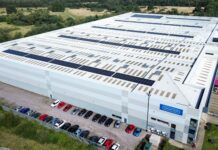Diesel-based non-road mobile machinery on construction sites is a significant contributor to air pollution. Mobile solar lighting firm Prolectric makes the case for its replacement
POLLUTION from the exhaust emissions of construction plant and machinery has a major impact on air quality, especially in densely-populated towns and cities. Yet, its harmful impacts haven’t attracted the airtime accorded so far to road pollution from vehicles.
Nevertheless, carbon dioxide, nitrogen oxides (NOx) and particulates emissions from mobile machinery in building and infrastructure projects threaten the well-being of construction workers every day, as well as of people living and working nearby.
More than 40,000 deaths in the UK are attributed to poor air quality, with emissions from diesel engines a major contributor. The London Atmospheric Emissions inventory estimates that NRMM used on construction sites in the capital are responsible for approximately 7% of NOx emissions, 8% of PM10 large particle emissions, and 14.5% of PM2.5 emissions.
Non-road mobile machinery and pollution
Progressive measures are in place to regulate this sector, known collectively as Non-Road Mobile Machinery (NRMM) through European and UK legislation, but they lag behind on-road regulation. As a result, NRMM air pollution is expected to rise proportionately as measures such as electric cars reduce on-road emissions.
The Mayor of London, Sadiq Khan has said he wants more powers to police air pollution from construction activity. In London the levels are dangerously high: NRMM is the second largest source of ultra-fine particulate matter (PM 2.5) emissions and the fifth largest source of oxides of nitrogen in London. The NRMM Low Emission Zone (NRMM LEZ) imposes minimum emissions standards for machinery used on major developments, but Khan wants to get tougher on all uses of NRMM across Greater London. He has also proposed a Green Machines NRMM positive recognition scheme and called for a national NRMM database.
For construction firms across the UK, achieving anything close to zero emissions seems a distant goal. Transitioning to renewable energy sources is an uphill struggle, both for construction and the plant hire businesses that serve them. That’s partly because of a UK construction fleet which varies so much in age and type, and the added confusion of hybrid technologies and engine upgrades – all of which still leave some element of polluting emissions remaining. The Government’s plan to introduce separate Clean Air Zones (CAZs) operated by local authorities in different parts of the country seems unlikely to make life any less complicated.
Replacing diesel generators
At Prolectric, we have been privileged to encounter forward-thinking construction firms who are already squaring up to their responsibilities for improved air quality and worker safety and are committed to implementing good environmental practice.
Now, developments in solar technology are offering them a straightforward opportunity to replace conventional internal combustion or even hybrid technology for one common type of NRMM: Diesel-generator tower lights are a common sight on construction projects up and down the country with a UK fleet running into many thousands. Temporary solar lights provide a quick and easy opportunity for contractors to improve their emissions performance – an option that also brings welcome additional operational benefits for site managers.
Benefits of temporary solar lighting
Solar-powered temporary lighting from Prolectric is a reliable year-round technology. Not only does it offer ‘like-for-like’ performance to diesel with powerful LED illumination, the technology brings contractors extra advantages with no noise to worry about in heavily-populated urban areas or worker compounds for motorway and transport projects.
Based on our experience as the market leader of solar-only street lights, we developed the Prolectric ProLight lighting tower to have high-power capacity, three times that of any other temporary solar trailer lights on the market. So, even on winter days with 16 hours of darkness, the unit operates consistently and reliably.
We built ‘smart’ technology into the ProLight so the unit’s on and off times could be controlled automatically and data on power usage and carbon savings can be monitored and recorded remotely.
Where it’s deployed
UK trials with main contractors began earlier this year in the UK and have been extremely successful. Hundreds of our mobile solar lights have been hired or are now permanently owned by contractors including Skanska, Costain, Carillion Rail, Kier BAM and Balfour Beatty. The Prolectric ProLight trailer light and the smaller ProTemp portable solar light, are currently being used on high-profile projects including the M1 Smart Motorway, the A14, HS2 and Hinkley Point C, as well as on infrastructure projects in inner London.
Contractors tell us what they like most is the ability to leave the lights to operate without having to make repeat trips to switch them on and off, or to refuel them. Because there’s no diesel, there’s no danger of spills.
The Prolectric ProLight comprises a specially-developed trailer-mounted unit with heavy-duty, deep-cycle batteries, an array of four or three high powered solar panels, a 7.5m telescopic mast and four LED lights supplying up to 400 watts and 60,000 lumens output.
The Prolectric ProTemp is a smaller standalone light with the LED luminaire located at a height of 3m or 5m from ground level, mounted on a concrete base.
Each light is fitted with an infrared sensor to optimise power usage in the unit. A bright light is activated when the area is entered by a vehicle or person. When the area is unused this ‘smart eye’ technology switches off to save battery usage and minimise light pollution.
Air pollution has been linked to premature deaths from a variety of illnesses. Switching to mobile lighting offers contractors and event organisers a quick and simple technology transition. Especially when multiple lights are used on major projects, this technology reduces emissions and is a very visible sign of a contractor’s commitment to health and safety and corporate social responsibility.







